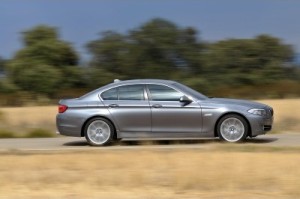 Instantly recognizable, BMWs are very popular status symbols. As people climb the corporate ladder, the numbers on the back of their BMW grow. If you look beyond the perceived status that comes with purchasing a Bimmer, you see a well-designed and engineered vehicle that’s always engaging to drive. Now, BMW has announced the new 2011 5-Series.
Instantly recognizable, BMWs are very popular status symbols. As people climb the corporate ladder, the numbers on the back of their BMW grow. If you look beyond the perceived status that comes with purchasing a Bimmer, you see a well-designed and engineered vehicle that’s always engaging to drive. Now, BMW has announced the new 2011 5-Series.
For this round, BMW has chosen to modify the 7-Series’ larger platform for use for this generation of the 5-Series sedan. This cuts research and development costs, and gives the 5-Series a better platform for hosting new derivates such as the 5-Series GT. The new lines on the 5-Series are deceiving. Whereas the previous generation’s “Bangled” look made the car seem bigger than it really was, the new lines do the opposite. This is extra surprising when you remember that the donor platform for this car is a much larger sedan!
 Besides chopping the 7-Series platform to down to size, BMW also saw fit to return to a more driver-centric cockpit, which means they’ve probably angled the center stack, which houses the radio and optional 10″ navigation screen, towards the driver, as in previous models. Another throwback is the distinctive kidney-shaped BMW grille being canted forward slightly, as seen on the iconic BMW 2002, among others.
Besides chopping the 7-Series platform to down to size, BMW also saw fit to return to a more driver-centric cockpit, which means they’ve probably angled the center stack, which houses the radio and optional 10″ navigation screen, towards the driver, as in previous models. Another throwback is the distinctive kidney-shaped BMW grille being canted forward slightly, as seen on the iconic BMW 2002, among others.
 Under the hood, BMW is providing three engines for the 5-Series, from a regular 6-cylinder engine (523/528 models), to a turbocharged 6-cylinder (535), to the range-topping turbocharged 8-cylinder (550). All but the base engine appear to be new designs, even though they are the same sizes as before. New technologies in the engines should give better fuel economy, while keeping the same performance level.
Under the hood, BMW is providing three engines for the 5-Series, from a regular 6-cylinder engine (523/528 models), to a turbocharged 6-cylinder (535), to the range-topping turbocharged 8-cylinder (550). All but the base engine appear to be new designs, even though they are the same sizes as before. New technologies in the engines should give better fuel economy, while keeping the same performance level.
So, what does this mean to us? As each of BMW’s cars gets bigger, the prices go up on each, and the smallest BMW on sale in America, the 1-Series, becomes relevant. Look for an interior and driving experience warranting the extra cost of the 5-Series, given its new underpinnings.
by John Suit
Source: BMW

